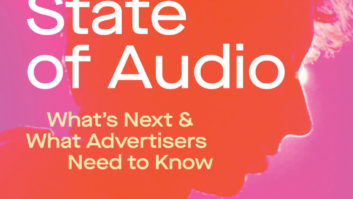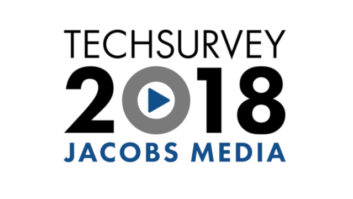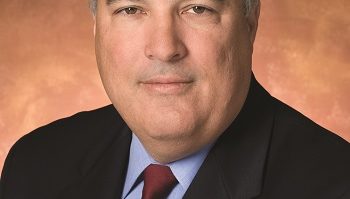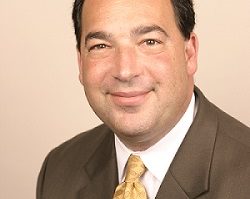
Seven vehicles were featured in iBiquity’s booth, which stretched the length of the exhibit hall. The seventh, outfitted by consumer electronics retailer Car Toys, is obscured on the far right.
Credit: Photo by Randy Richter, iBiquity Digital
Is radio preparing for a future where the marketplace is becoming increasingly competitive and unpredictable? Does radio’s future mean terrestrial, streaming or both?
NAB President/CEO Gordon Smith has asked broadcasters to think about those questions.
Indeed, at the recent Radio Show convention in Dallas, Big Machine Label Group and Clear Channel discussed their headline-making revenue/royalties deal; and Entercom signed a similar agreement with Big Machine during the conference.
Big Machine Label Group President/CEO Scott Borchetta said the agreement takes into account how radio is being used now, and where it will be listened to in the future, namely on portables devices.
Some radio owners said such direct deals are not applicable to much of the smaller industry owners, and are specific to the large radio groups involved.
As the show ended, the Internet Radio Fairness Act was introduced in Congress by Utah Republican Rep. Jason Chaffetz and Colorado Democrat Jared Polis. The bill seeks to level the playing field for music royalties among streamed digital audio services. Entities like Pandora, Clear Channel, NAB and CEA praised the measure while the musicFirst Coalition opposed it. The bill promises to set the stage for a royalties push in the new Congress this January.
While the music royalty issue was a backdrop for broad discussions among station owners, the nuts-and-bolts of daily operations that really take up executives and engineers time loomed larger in the sessions and exhibit hall.
How the FCC can make life easier for beleaguered AMs was a big topic, as was how remain radio can remain relevant in the dash and the FM chip issue. Emmis CEO Jeff Smulyan spoke of “incentivizing” carriers to activate and also include radio chips in their devices.
Here is a final roundup of the more notable news from the fall event and afterwards:
DIGITAL ‘WILL HELP RADIO GET SOME OF ITS SEXY BACK’
Mobile is the best opportunity for radio in the digital space, according to Clear Channel President of National Ad Platforms Jim Castelli.
“It fits for radio and it fits into what people use the phone for,” Castelli said at the Radio and Internet Newsletter Summit. “When it’s on a mobile phone it just sounds like your best friend telling you to go buy that car or go see that movie.” That can be a powerful tool for advertisers, he believes.

FCC Audio Division Chief Peter Doyle
Credit: Photo by Leslie Stimson
However Castelli believes radio has an image problem. While the medium still resonates with a lot of consumers and has “huge” reach, traditional radio has lost some of its luster among advertisers, though he still believes it’s still one of the “big three” for media, along with TV and the Web.
Digital, he said, will help radio “get some of its sexy back.” Digital, meaning streamed radio, “amplifies everything we know is great about radio. It’s personal, it’s local. It’s social,” he said.
He encouraged attendees to think of digital as “in addition to,” not “instead of” broadcast radio.
FCC COULD ACT SOON ON FM TRANSLATOR CAPS
Look for the FCC to take action soon on the agency’s proposed translator caps.
In order to sort through the roughly 6,500 pending FM translator applications to reach a more manageable amount as well as preserve frequencies for more low-power FM stations, the commission in March proposed limits. It proposed a national cap of 50 applications per ownership group and a per-market cap of one application in the top 156 radio metros.
Four broadcasters, including Educational Media Foundation, have challenged the caps, calling them arbitrary. They’ve asked the agency to reconsider the limits.
Wilkinson Barker Knauer partner David Oxenford, who represents EMF, said “We were surprised by the number of people who objected to a market cap of one. I think there are issues for the FCC to work out.”
FCC Audio Division Chief Peter Doyle characterized the petitions as asking the commission “to tighten up some of the definitions in the order.” The agency is close to sending those recommendations to the commissioners on the eighth floor as an order on reconsideration, he said.
“We see translator processing as a first step. We want to push that down the tracks first,” Doyle said, before the agency opens an application window for LPFMs. He can’t predict how long it will take to resolve the translator issue.
Audio Division Deputy Chief Jim Bradshaw says the project has the chairman’s attention.

Womble Caryle partner John Garziglia & NAB SVP/Deputy General Counsel Ann Bobeck
Credit: Photo by Leslie Stimson
Meanwhile Lerman Senterattorney Dennis Corbett says radio owners who don’t have a pending FM translator app and who want a translator should act now to “get their engineer to scour the FCC database to find a dance partner,” meaning a radio group that’s approaching the cap. “You need to approach them now. If they approach the cap, they’ve got tough decisions to make,” he said. A potential agreement with other broadcasters will affect which ones they keep.
PAI’S CALL FOR AM REVIEW IS WELL RECEIVED
Broadcasters who owns AMs are cheering FCC Commissioner Ajit Pai’s call for the agency to look at AM reforms to help the service.
Bryan Broadcasting Vice President/General Manager Ben Downs, who’s also an NAB radio board member, to Pai’s call for the formation of an AM Revitalization Committee in 2013 by calling it the best news he’s had in some time. “The commissioner realizes that AM has an important role to play in serving communities and realizes that rules put into place 90 years ago have little relevance today,” he told Radio World. “I hope he’s willing to embrace broad changes to the rules because no amount of programming nor local service will allow a daytimer to serve their community in morning drive. AM needs 21st century rule changes and a new path to implement 21st century technology.”
Womble Carlyle attorney John Garziglia says most of the AMs that need help are in medium and small markets. “If you look at AM operators as not just having a stick in the ground, FM translators is one of the few things that can be done now.”
There are several things the FCC can do immediately to help them, however in speaking to Radio World, he focuses on two items: the commission should not dismiss pending FM translator applications from 2003 and should expand how many AMs can operate on FM translators.
A way of accomplishing that today, Garziglia says, would be for the agency to ease its “no hopping” restriction. “Hopping” is when a translator owner, trying to move closer to a more populated market, does that by degrees, even perhaps operating the translator from a truck by the side of the road in one location for a day, then shutting down and moving as soon as the next location is approved. “The truck people are doing it this way because it’s the only way they can do it” under current FCC rules, according to the attorney.
Asked whether moving some AMs to spectrum now used for the television analog Channels 5 and 6 is a good idea, Garziglia says yes, however that could potentially face a court challenge from TV owners that wish to remain on those channels and new receivers would be needed in the marketplace. Even if the process went smoothly, it could take 10 years, Garziglia said.
EXECUTIVES: RADIO NEEDS TO INCENTIVIZE CARRIERS ON FM CHIPS
How can radio persuade wireless carriers to embed FM chips in mobile devices, or activate the chips that are already there?

From left: Cumulus Media Chairman/CEO Lew Dickey and Cherry Creek Radio President/CEO Joe Schwartz Credit: © NAB/RAB A legislative solution doesn’t appear to be at hand, nor is it the way to go, radio executives agree, so the focus is now on incentivizing the carriers.
Shortly after the show, Emmis CEO Jeff Smulyan said the tenor of the tone of the discussions with the carriers has changed dramatically for the better; he believes radio is closer to nudging the wireless industry on the issue.
“Let’s reach the best business interests we can through negotiation,” Smulyan said.
At the show, Cumulus Media Chair/CEO Lew Dickey says there needs to be an educational process for consumers — presumably by radio — to let them know an FM chip is in their phone. Part of the campaign would be to prod consumers tell their carriers know they want those chips activated. Radio needs to incentivize the carriers, who also are radio advertisers, he said, adding that some 15 million cars are sold in the U.S. each year, yet twice as many cellphones are sold.
Smulyan said radio is poised to give the carriers “millions in subsidizing.” The industry hopes to make it worth the while for the carriers to embed or activate existing FM chips, Smulyan said.
SMARTPHONE CHIP WORK NOW INCLUDES FM ANALOG
Both Emmis CEO Jeff Smulyan and Cumulus Media Chair/CEO Lew Dickey say having an FM radio chip is vital, however that development effort is now tied to FM analog as well as HD Radio.
Shortly after the show, Emmis announced it would sell its interactive division to Marketron, in part to focus on TagStation, the broadcast insertion system that makes it possible for a consumer to interact with a radio station enabled by the connectivity of the mobile device.
The so-called “backchannel” ecosystem and smartphone app debuted at the spring show as an NAB Lab-funded effort of Emmis, Intel and iBiquity Digital.
TagStation now has a focus on analog FM using RDS as well as HD. Emmis Chief Technology Officer Paul Brenner described it as “baby steps.” While the group built a prototype smartphone to demonstrate to carriers the data value of an FM HD chip, carriers have been reluctant to embrace the concept, he said, noting that the HD chip would also cost carriers more than $2 per phone, above the their typical ceiling of 40 cents per device for new technology.
For a variety of reasons, HD stations too have been slow to implement Artist Experience and that gives carriers pause as well. “TagStation works for analog, too. So even analog gets some of the visual experience” of the audio synched with the visual on the receiver display, Brenner said.
“We tell automakers ‘This is radio now. It’s not just a call sign and frequency,’” said Brenner. And that, in turn, opens doors with the carriers and changes those conversations, he said.
Indeed, project developers are now using the term “hybrid radio” when talking to device makers and carriers. Emmis Interactive Director of Product Development Ben Husmann demoed a Samsung Galaxy S smartphone that includes an activated FM chip. He demoed a station’s “text to win” campaign; with a station list populated by the phone number.
“Why are we doing this?” he asked rhetorically. “Because when we talk to a chipmaker, we can say, ‘This is your chip on a Samsung. Here’s what’s possible. The conversation is, what is radio doing to innovate?”
Emmis is also studying what kind of data stations can get from a listener using a device. “We know what station they listen to and where they were. We know they heard a particular event and how they viewed it,” he said.
Emmis says it’s signed some top 10 market radio broadcasters for TagStation but hasn’t released their names.
AUTOMAKERS GET HD COMPLAINTS; TIME ALIGNMENT MAY BE AUTOMATED
For years, there were more stations transmitting digital signals than there were HD-equipped cars on the road. Now automakers are ahead of broadcasters, rolling out more cars equipped with advanced HD Radio receivers that feature dynamic visual displays.
But even when HD stations do implement HD Radio or put a multicast channel on the air, they’re not always able to pay attention to the alignment of the analog and digital signal. That’s a problem, because complaints about audio quality are starting to arrive at dealerships.
IBiquity Senior Vice President of Broadcast Programs & Advanced Services Joe D’Angelo ticked off several: Customers say the HD often echoes as if two signals are being received slightly out of time or the audio sounds as if the station is “skipping.” Other complaints include “the radio doesn’t pick up HD stations, ever.” Or “The HD goes in and out.”
Many of these complaints involve alignment of the analog and digital signals.
Some transmission and monitor manufacturers are working with iBiquity to determine whether that function can be automated, with an eye toward having those upgrades ready for the spring NAB convention. That commercialization would be helped if monitor manufacturers saw an interest from stations in that feature, D’Angelo said.
Owners have been slow to embrace the advanced data features that can make a radio display look like its competitors, such as satellite radio or Pandora, in the dash. Only some 400 stations have so far and that’s a problem, according to HD proponents; they believe that if stations don’t step it up, automakers will move radio “down the center stack of priorities in the dash,” so to speak.
IBiquity Digital President/CEO Bob Struble stressed the point to Radio World, noting that 9 million HD Radio receivers have been sold to date.
Ninety-four automotive models in calendar year 2013 will have HD Radio as a standard feature. “You’ll be hard-pressed to find a new car in the U.S. that doesn’t have it,” predicted D’Angelo.
Over the next 12 months, eight OEMs will launch Artist Experience in 19 models. With AE, the digital audio is synched with visual elements for a dynamic display in today’s large-screen in-dash enfotainment systems.
The company is stressing the importance of station owners raising their digital power levels to implementing AE or iTunes Tagging.
Clear Channel has implemented AE at many stations. Greater Media has implemented AE on all of its digital FMs, and CBS Radio will be rolling out AE in its top four markets by year-end, according to Senior Vice President of Engineering Glynn Walden.
“There are people implementing it,” said Emmis CTO Paul Brenner, but that number “needs to get better.”
JOURNAL EXPANDS HD COMMITMENT
About half of Journal Broadcast Group’s 35 stations are transmitting in digital and the plan is to take the rest of the group digital next year. So says Vice President/Chief Technology Officer Andy Laird. He said the company is raising FM digital power on three stations now and working on implementing Artist Experience, with plans to also roll that out next year.
Journal would then join other radio groups, like Clear Channel and Greater Media, in implementing the advanced data feature of HD Radio in which the audio is synched with visual images on a receiver display.
Laird said he’s standardized a lot of what goes into organizing, storing and transmitting album art with the digital signal.
Ford Business Development Analyst for Mobile Scott Burnell estimated that 50 percent of new cars available now have some type of large-screen infotainment system. Consumers “want everything,” basically, “the ability to do what they do outside the car” and to bring that functionality into the vehicle, he said.
That percentage is expected to grow to roughly 80 percent next year.
IBiquity Digital President/CEO Bob Struble said “We’re getting to a point where if you’re not digital at your station, you’re going to be at a disadvantage,” noting that the new auto infotainment systems just display the call signs of an analog station.
Not everyone is onboard the digital train.
Cherry Creek Radio CEO Joe Schwartz is afraid radio will be split among those stations that can and those that cannot afford to spend thousands of dollars on new technology.
“It would cost my company in excess of $10 million to go to an HD platform. That is not going to happen.” He knows other small broadcasters “who probably feel the same way.”
‘PANDORA’ = STREAMING TO EARLY ADOPTERS
Streamed radio is maturing in the minds of early adopters.
“Years ago you couldn’t get consumers to criticize streaming radio,” said knowDigital Senior Research Analyst Kelly Ellis.
Now, consumers in focus groups might comment that Pandora is “old fashioned” or that sometimes audio on a streamed service cuts out. She spoke at the Radio and Internet Newsletter Summit.
Consumers also are beginning to use the word “Pandora” to describe the streaming category, she said, with the implication the personalized audio service “owns” the category.
Listeners typically use one or two streamed audio service. In focus groups, some are confused about what the brand iHeartRadio means, she said.
Clear Channel’s streaming service iHeartRadio has 1,500 custom stations and 10 million registered users, according to company President of National Ad Platforms Jim Castelli.










